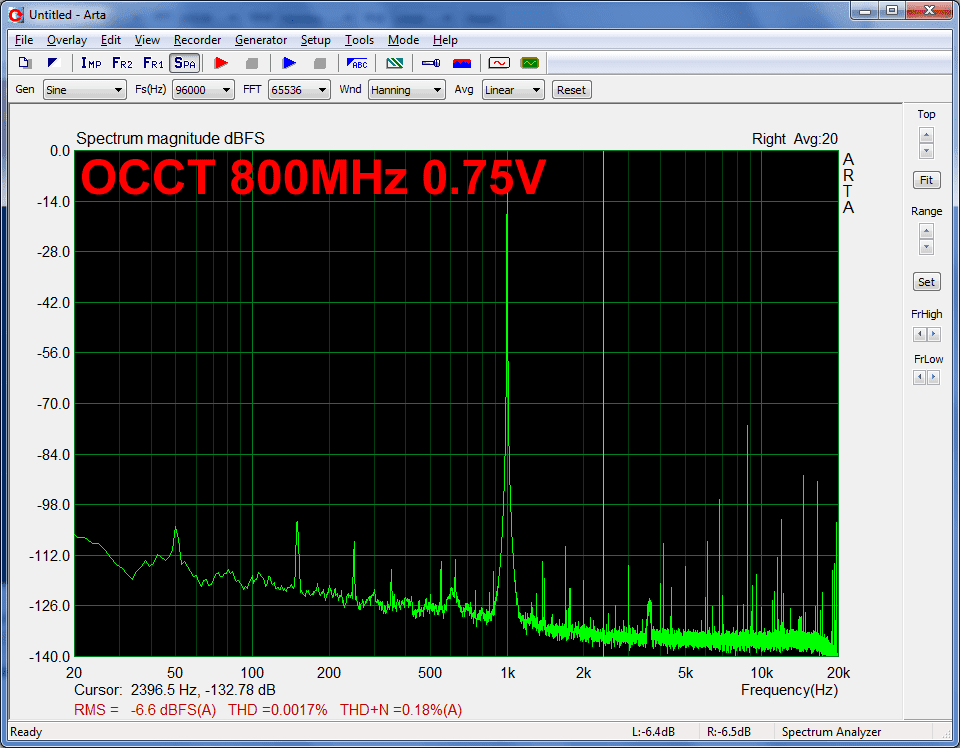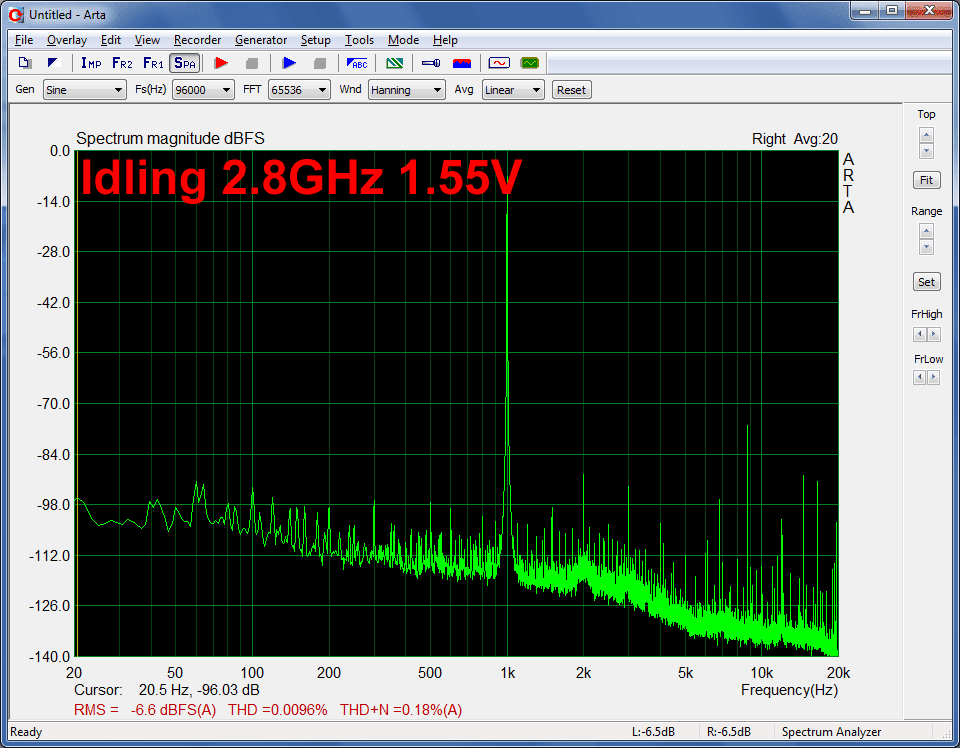This is a review and detailed measurements of the audio subsystem of my Gigabyte Z390 Z390 Aorus Master "gaming" motherboard. It was kindly built into my system by member @mkawa and is my everyday workhorse that runs all the measurements you see. It costs US $290 including Prime shipping from Amazon.
Besides being a high-end PC motherboard, it advertises appetizing audio specifications:

An ESS ES9118 DAC chip is used which has an advertised SINAD of 112 dB. If achieved, this would rival and beat many budget desktop DACs.
DAC Audio Measurements
There is multi-channel analog output plus a dedicated headphone output. The former is on the back and latter on the case. Let's start with line out in the back:

Output is limited to 1.1 volts which is way short of nominal 2 volts a DAC is supposed to produce. Distortion is rather high and dominates SINAD (figure of merit of distortion+noise) to the tune of 91 dB. This is well short of the ES 9118 specifications and lands the Z390 motherboard in "OK domain:

That said, for PC motherboard this is not bad. My last PC motherboard, the Gigabyte B8 only reached 83 dB. And a Dell XPS 8930 retailing for US $1,000 finished dead last in above chart at just 43 dB!
Dynamic range is actually quite good especially in one channel:

You have plenty of headroom to not add noise to any CD/16-bit format.
32-tone test track resembling "music" did not do any better than what we have already seen:

Intermodulation distortion+noise shows the same:

Filter response is the first "correct" one I have seen in a long time:

It nicely truncates anything past half the sampling rate at 22.05 kHz. Most DACs go out to 24 kHz which allows some aliasing. Attenuation of -70 dB is not a lot though and we see that it causes some problems later.
Jitter is not clean but not as bad as people dread on a motherboard DAC:

Distortion+noise with 90 kHz bandwidth shows problems relative to frequency:

This test is never complete however without diagnosing what is contributing to it. That is, whether we have that high of noise and distortion in audible band or something else is amiss. So let's look at the spectrum:

We see the problem to far right. That spike is there because the DAC reconstruction filter did not attenuate enough which allows our 1 kHz tone to alias there. Fortunately it is not audible so more of a measurement issue than performance.
I kept the best news for last:

This is stunningly accurate linearity which even expensive DACs struggle with at times. The Z390 ES9118 DAC is well implemented to produce the correct output voltage down to a whopping -120 dB/20 bits. Can't ask for much more!
Headphone Output Measurements
Let's start with our dashboard of 2 volts out:

We see some loss of performance relative to line out but we are getting nearly double the output so this is not so bad.
Performance is actually respectable but sadly not much power:

Switching to 33 ohm load, sharply reduces output power:

When this happens, usually it means the output impedance is too high and boy is it high:

It is one of the worsts I have ever measured in any audio product! Consequences are listed on the graph. I suggest staying with high impedance headphones (at least 300 ohm).
Conclusions
Considering how bad PC implementations of audio can get, the Gigabyte Z390 Aorus actually does well. Grading on a curve, it is one of the best audio subsystems I have seen in a PC. In absolute terms though, a $99 DAC will run circles around it but audible difference may be fleeting. In other words, what is there is "good enough."
What is not good enough is the headphone output with its dismally high output impedance and inadequate output power especially with low impedance headphones. There are headphone dongles that do better than this output!
Overall, I take the rather clean multi-channel line out and give a passing grade to Gigabyte Z390 Aorus audio subsystem. Get yourself a headphone amp and you may be good to go without having to get a DAC to go with it.
-----------
As always, questions, comments, recommendations, etc. are welcome.
I was watching this youtuber saying he has quit his regular job and aims to do a video almost every day. I have been doing a review everyday and don't recall getting enough money to quite my job. Or wait. I already quite my job for other reasons. Darn. Until I think of another reason to beg for money, why don't you donate anyway using : https://www.audiosciencereview.com/forum/index.php?threads/how-to-support-audio-science-review.8150/
Besides being a high-end PC motherboard, it advertises appetizing audio specifications:
An ESS ES9118 DAC chip is used which has an advertised SINAD of 112 dB. If achieved, this would rival and beat many budget desktop DACs.
DAC Audio Measurements
There is multi-channel analog output plus a dedicated headphone output. The former is on the back and latter on the case. Let's start with line out in the back:
Output is limited to 1.1 volts which is way short of nominal 2 volts a DAC is supposed to produce. Distortion is rather high and dominates SINAD (figure of merit of distortion+noise) to the tune of 91 dB. This is well short of the ES 9118 specifications and lands the Z390 motherboard in "OK domain:
That said, for PC motherboard this is not bad. My last PC motherboard, the Gigabyte B8 only reached 83 dB. And a Dell XPS 8930 retailing for US $1,000 finished dead last in above chart at just 43 dB!
Dynamic range is actually quite good especially in one channel:
You have plenty of headroom to not add noise to any CD/16-bit format.
32-tone test track resembling "music" did not do any better than what we have already seen:
Intermodulation distortion+noise shows the same:
Filter response is the first "correct" one I have seen in a long time:
It nicely truncates anything past half the sampling rate at 22.05 kHz. Most DACs go out to 24 kHz which allows some aliasing. Attenuation of -70 dB is not a lot though and we see that it causes some problems later.
Jitter is not clean but not as bad as people dread on a motherboard DAC:
Distortion+noise with 90 kHz bandwidth shows problems relative to frequency:
This test is never complete however without diagnosing what is contributing to it. That is, whether we have that high of noise and distortion in audible band or something else is amiss. So let's look at the spectrum:
We see the problem to far right. That spike is there because the DAC reconstruction filter did not attenuate enough which allows our 1 kHz tone to alias there. Fortunately it is not audible so more of a measurement issue than performance.
I kept the best news for last:
This is stunningly accurate linearity which even expensive DACs struggle with at times. The Z390 ES9118 DAC is well implemented to produce the correct output voltage down to a whopping -120 dB/20 bits. Can't ask for much more!
Headphone Output Measurements
Let's start with our dashboard of 2 volts out:
We see some loss of performance relative to line out but we are getting nearly double the output so this is not so bad.
Performance is actually respectable but sadly not much power:
Switching to 33 ohm load, sharply reduces output power:
When this happens, usually it means the output impedance is too high and boy is it high:
It is one of the worsts I have ever measured in any audio product! Consequences are listed on the graph. I suggest staying with high impedance headphones (at least 300 ohm).
Conclusions
Considering how bad PC implementations of audio can get, the Gigabyte Z390 Aorus actually does well. Grading on a curve, it is one of the best audio subsystems I have seen in a PC. In absolute terms though, a $99 DAC will run circles around it but audible difference may be fleeting. In other words, what is there is "good enough."
What is not good enough is the headphone output with its dismally high output impedance and inadequate output power especially with low impedance headphones. There are headphone dongles that do better than this output!
Overall, I take the rather clean multi-channel line out and give a passing grade to Gigabyte Z390 Aorus audio subsystem. Get yourself a headphone amp and you may be good to go without having to get a DAC to go with it.
-----------
As always, questions, comments, recommendations, etc. are welcome.
I was watching this youtuber saying he has quit his regular job and aims to do a video almost every day. I have been doing a review everyday and don't recall getting enough money to quite my job. Or wait. I already quite my job for other reasons. Darn. Until I think of another reason to beg for money, why don't you donate anyway using : https://www.audiosciencereview.com/forum/index.php?threads/how-to-support-audio-science-review.8150/



